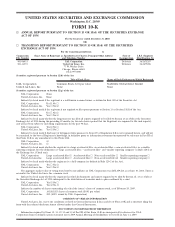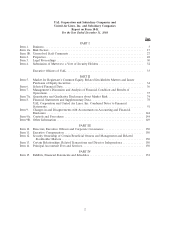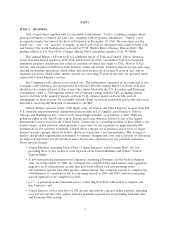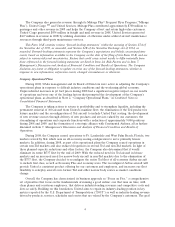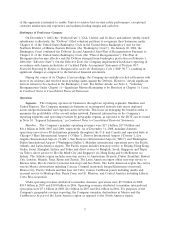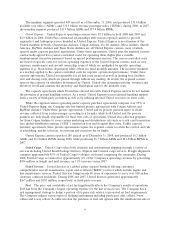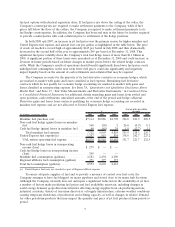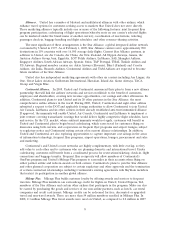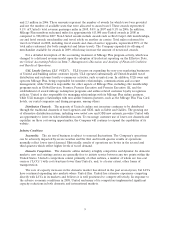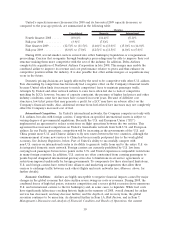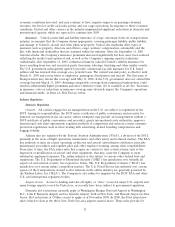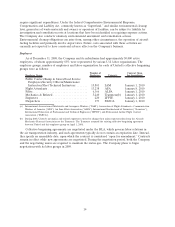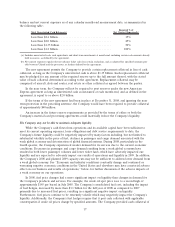United Airlines 2008 Annual Report Download - page 9
Download and view the complete annual report
Please find page 9 of the 2008 United Airlines annual report below. You can navigate through the pages in the report by either clicking on the pages listed below, or by using the keyword search tool below to find specific information within the annual report.and 2.3 million in 2006. These amounts represent the number of awards for which travel was provided
and not the number of available seats that were allocated to award travel. These awards represented
9.1% of United’s total revenue passenger miles in 2008, 8.0% in 2007 and 8.1% in 2006. In addition,
Mileage Plus members redeemed miles for approximately 613,000 non-United awards in 2008 as
compared to 928,000 in 2007. Non-United awards include awards such as Red Carpet club memberships,
car and hotel awards, merchandise and travel solely on another air carrier. Total miles redeemed for
travel on United in 2008, including travel awards and class-of-service upgrades, represented 89% of the
total miles redeemed (for both completed and future travel). The Company expanded its offering of
merchandise available for awards in 2009, which may increase the amount of non-travel awards.
For a detailed description of the accounting treatment of Mileage Plus program activity, which was
changed to a deferred revenue model upon the adoption of fresh-start reporting on the Effective Date,
see Critical Accounting Policies in Item 7, Management’s Discussion and Analysis of Financial Condition
and Results of Operations.
UAL Loyalty Services, LLC (“ULS”). ULS focuses on expanding the non-core marketing businesses
of United and building airline customer loyalty. ULS operates substantially all United-branded travel
distribution and customer loyalty e-commerce activities, such as united.com. In addition, ULS owns and
operates Mileage Plus, being responsible for member relationships, communications and account
management; while United is responsible for other aspects of Mileage Plus, including elite membership
programs such as Global Services, Premier, Premier Executive and Premier Executive 1K, and the
establishment of award mileage redemption programs and airline-related customer loyalty recognition
policies. United is also responsible for managing relationships with its Mileage Plus airline partners,
while ULS manages relationships with non-airline business partners, such as the Mileage Plus Visa Card,
hotels, car rental companies and dining programs, among others.
Distribution Channels. The majority of United’s airline seat inventory continues to be distributed
through the traditional channels of travel agencies and GDS, such as Sabre and Galileo. The growing use
of alternative distribution systems, including www.united.com and GDS new entrants, provides United with
an opportunity to lower its ticket distribution costs. To encourage customer use of lower-cost channels and
capitalize on these cost-saving opportunities, the Company will continue to expand the capabilities of its
website.
Industry Conditions
Seasonality. The air travel business is subject to seasonal fluctuations. The Company’s operations
can be adversely impacted by severe weather and the first and fourth quarter results of operations
normally reflect lower travel demand. Historically, results of operations are better in the second and
third quarters which reflect higher levels of travel demand.
Domestic Competition. The domestic airline industry is highly competitive and dynamic. In domestic
markets, new and existing carriers are generally free to initiate service between any two points within the
United States. United’s competitors consist primarily of other airlines, a number of whom are low-cost
carriers (“LCCs”) with cost structures lower than United’s, and, to a lesser extent, other forms of
transportation.
The rate of capacity increases in the domestic market has slowed in the past several years, but LCCs
have continued expanding into markets where United flies. United has extensive experience competing
directly with LCCs in its markets and believes it is well positioned to compete effectively. In response to
the adverse economic conditions in 2008, United and many of its competitors implemented significant
capacity reductions in both domestic and international markets.
9

